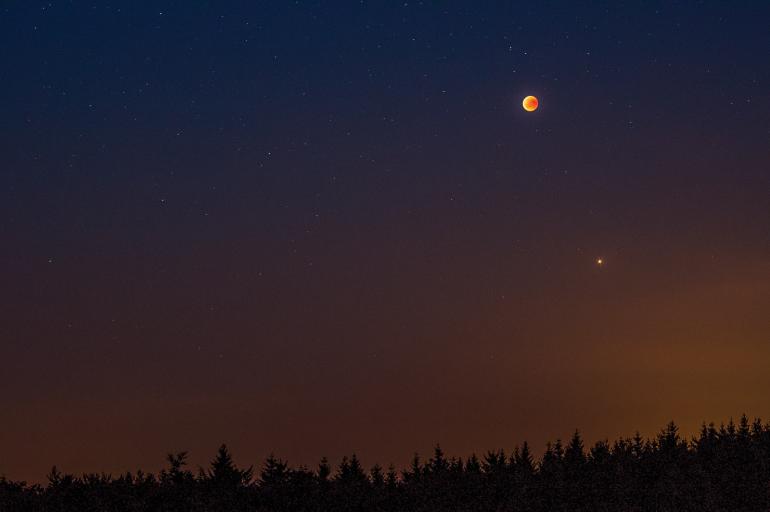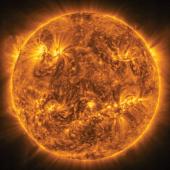Celestial Swap
Switching roles with the red planet.
“That Mars is inhabited by beings of some sort or other we may consider as certain as it is uncertain what these beings may be.” So wrote astronomer Percival Lowell early in the last century, when his telescopic observations of the planet seemed to show lines etched in the ochre surface and he turned them into the irrigation canals of an ancient civilization.
Lowell and others claimed to have found these features during the times when Mars was in “opposition” and closest to Planet Earth for observing. His Martian canals have long been disproven as optical illusions, but Mars is once again in opposition this winter, and eminently observable.
Mars’ garish color, making it look like a drop of blood, may have been much responsible for its association with the Roman god of war, his Greek counterpart Ares, and the Babylonian Nergal, a deity of war and disease.
Oppositions of Mars occur every 26 months, when our speedier Earth in its closer orbit to the sun passes Mars in its farther orbit. That puts Earth between Mars and the sun, which means that Mars lies opposite the sun in our sky, rising in the east at sunset, visible all night. Mars reaches opposition on the night of January 15-16.
On that night, it rises lined up with and just below Castor and Pollux, the two bright stars in the constellation of Gemini the Twins, which lies up and left of Orion’s familiar rectangular pattern enclosing the three stars of the hunter’s belt. And it glows unmistakably red. But Mars will be outshined by the planet Jupiter, lying on the other side of Orion in the horns of Taurus the bull—and not far from the red star Aldebaran in Taurus’ V-shaped face. These two will add to the glittering panoply of the starry winter sky.
Mars’ garish color, making it look like a drop of blood, may have been much responsible for its association with the Roman god of war, his Greek counterpart Ares, and the Babylonian Nergal, a deity of war and disease. Perhaps it’s no wonder, then, that as Lowell mused about intelligent Martian ditch-diggers, H. G. Wells made them invaders in The War of the Worlds. Ever since, science fiction has been littered more with ravaging Independence Day harvester queens than benevolent E.T.s.
Those with access to sizable telescopes in steady air this winter will be able to view the planet’s small, orangish disk.
In fact, the invasion has gone the other way, as Earth regularly hurls orbiters and landers at Mars, still searching for Martians of any sort, though the sorts we’re looking for now are microbial in nature—either fossils of past life on the planet, or perhaps bacteria-like residents still doing business in protected underground environments. The jury remains out.
In the meantime, those with access to sizable telescopes in steady air this winter will be able to view the planet’s small, orangish disk and note Mars nodding its north polar cap toward the sun as the cap shrinks in northern hemisphere Martian spring, with dark features possibly visible on its dusty iron-oxide plains.
Thereafter, Mars’ shifting position will make an ever-changing triangle with Castor and Pollux through the spring thaw. Prominent as the planet will be, however, the full moon tries its best to upstage it, passing in front of and occulting it on January 13, a few days before opposition, from about 7:09pm MST to 7:50pm. And on March 13-14, about a week before the spring equinox, the moon itself will turn red as it slips into the Earth’s shadow for a total lunar eclipse.
Mars’ shifting position will make an ever-changing triangle with Castor and Pollux through the spring thaw.
Partial eclipse begins at 11:09pm MDT on the 13th with the moon in the southeast. It passes entirely into the Earth’s umbra or central shadow by 12:26am on the 14th, when it will take on a ruddy hue not dissimilar from Mars as a result of sunset colors around Earth’s rim filtering through our atmosphere and into the shadow. It stays such until 1:31am when it begins to emerge, sliding completely out of the umbra by 2:47am to end the partial phase of eclipse.
Clearly, lurid sights await. And if it is indeed clear, bundle up, head outside, and enjoy all the sky has to offer these winter nights.
Jim Manning is the former executive director of the Astronomical Society of the Pacific. He lives in Bozeman.











